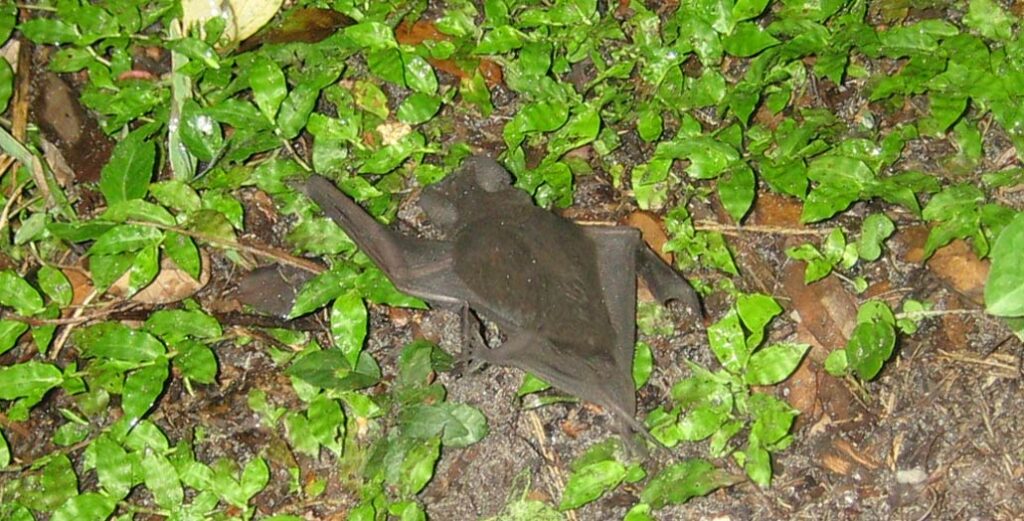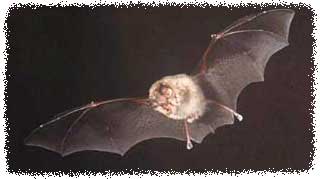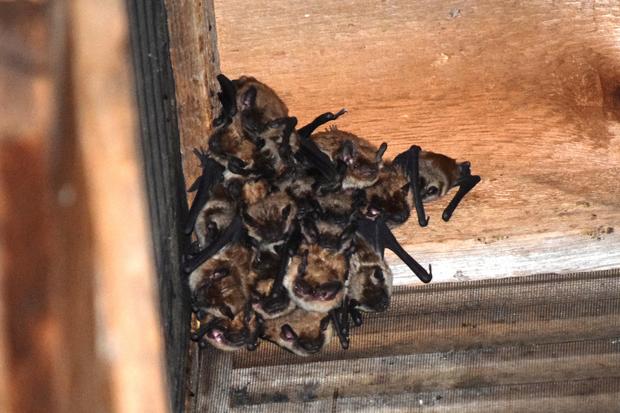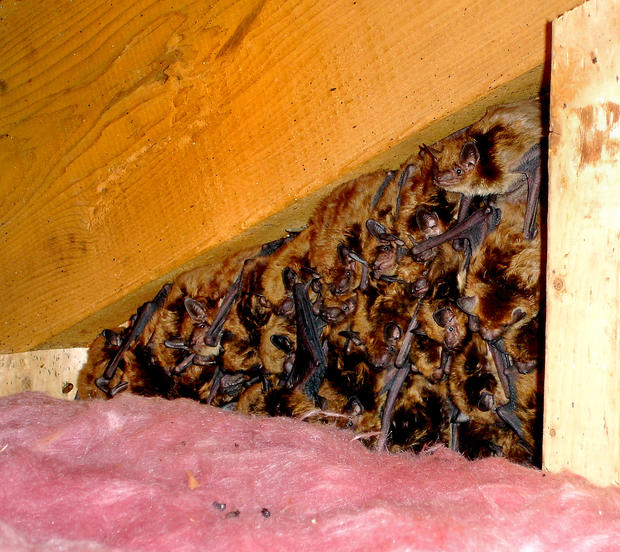HOW TO GET BATS OUT OF THE ATTIC
So, You have bats in your attic…..what do you do now? They cause extensive amounts of damage with scratching, chattering and piles of guano. They leave a horrible mess of feces. . They roost in large colonies, and if they have pups you can t move them.
To get rid bats in the attic, you need to follow a simple series of steps. Find out how the bats are getting in. Bats can fit through a space as small as 3/8 inch wide, so don’t overlook any crack or crevice! Inspect the whole roof structure, ridge row and eaves thoroughly. If you familiarize yourself with bat’s habits It will help you know what signs to look for. Bat holes will have a large concentration of black greasy residue around them.
You now know where the bats are roosting, and how they are getting in. You have determined if there are pups. You now have to decide their fate. Do you want to make them just leave? Do you want to kill them? Each of these choices has its own results. If you kill them, how do you do it, what do you do with the carcasses? Is that even legal in your area? If you make them leave, how do you keep them out, and where do they go? Once you have found all the holes and you have decided how to handle your infestation, you can look at options. If you decided to kill them, You could block all the holes to the attic at once and use poison. While this is possible, it’s not a very good choice.
Even if you don’t mind cleaning up the carcasses, this could take several days. In cleaning up you could miss one or two bodies, and you have to deal with residual poison left in your home. If you just want them to leave, Exclusion tunnels are a simple and versatile choice to get rid of the bats in your attic. They are even easy for you build or install, yourself with a few simple tools, a little time, and a few materials. With this method you would seal all but the busiest bat hole. The large end of the funnel is placed over that central whole the bat s use regularly. Exclusion funnels allow the bat to exit through its bat hole to the outside, but not be able to get back in. This is an effective way to force the bat to go elsewhere. After you are sure all the bat s have exited, remove the funnel, and seal up the final hole.
Read more about bat control in my educational articles. Find out if a bat house will prevent bats from entering your home, and whether or not the city or county animal services will help with a bat issue. Learn if a bright light or high pitch sound deterrent machine will work on bats, and if a bat in your attic will have a nest of babies. Find out if a pest control company will remove a bat, and whether it is Legal to trap bats.

How To Get Rid of Bats
SUMMARY: Step-by-step guide for getting rid of bats in a house or attic:
Step 1 – Watch the house at dusk, and observe where the bats fly out of, and how many there are.
Step 2 – Inspect the entire house or building, and find any and all entry gaps, as small as 3/8 inch.
Step 3 – Seal all secondary areas with caulk or other sealant, but leave the main entry/exit gaps open.
Step 4 – Set one-way exclusion netting or funnels on the primary areas. This is very tricky to get right.
Step 5 – Observe at dusk to make sure all the bats are able to get out of the one-way devices, and that they are not able to fly back in. If it’s not working, remove the exclusion material immediately.
Step 6 – If it’s working, leave in place for at least three days, until no more bats come out at dusk.
Step 7 – Remove the netting and seal shut those last entry gaps and holes.
Step 8 – Clean bat guano out of attic, decontaminate and deodorize the space.
WARNING – Never attempt a bat exclusion during the summer maternity season, when flightless baby bats are inside the attic. It’ll result in disaster, and it’s illegal as well.
Bat Info: There are a wide variety of bat species in the US, though it’s usually the colonizing bat types that cause problems in buildings. Bats are not flying mice, or even rodents. They are more closely related to shrews or primates. Though bats often get a bad reputation, they are not aggressive, and are often very beneficial in eliminating pesky insects. Bats aren’t blind. They can see just fine, but they also use echolocation as their means of navigating complex flight and finding insects on the wing. A bat’s wings are essentially the same as our arms and hands, thus the scientific name Chiroptera or handwing. The bones of the hand and finger are elongated and serve to support and move the wing. The hind limbs of bats are modified for landing and hanging upside-down.
Bats become a nuisance when they roost in large numbers in human dwellings. The rapid and smelly accumulation of guano (droppings) is unsanitary, and serves as a fertile breeding ground for a fungal disease called Histoplasmosis, which is transferable to humans who breathe in the fungal spores. Bats are also known to carry rabies, a viral disease that causes progressive paralysis and death in mammals, including humans
People are most likely to encounter nuisance bats when a roosting colony takes up residence in a building. Attics often make excellent habitat, as do barns. Read about How to Get Bats Out of Your Attic. Bats need only a half inch or less of space to crawl through in order to enter a building. Once inside, if the habitat is good, the colony grows until the homeowner notices the bats flying out of the building, notices the droppings in the attic, chimney, outside, or even basement (when the droppings fall down the walls). Sometimes a bat will get lost and find its way out of the attic and into the living area. Occasionally a transient bat may also fly into a house.
A professional bat removal system such as mine ensures that the colony will no longer use your home or business as a roosting area, and that no bats can get back in. We care for the welfare of these beneficial creatures, as do many environmental agencies, so we do not aim to kill any bats. A pro merely exclude them from the premises and make sure they can’t get back in, while thoroughly cleaning the biohazardous droppings that they leave behind. Experience counts when working on bat jobs, and it takes a skilled eye to get the job done right the first time.

How Much Does It Cost to Remove Bats?
The only mammal capable of flying, bats often invade homes, attics, and chimneys, making noise at night, damaging the structure of the home, and leaving hazardous waste in their path. While bats are an important part of the ecosystem, they belong outdoors, making bat removal and exclusion necessary services for homeowners.
Female bats are constantly on the prowl for a warm location to roost and eventually raise their young.They often occupy chimneys and attics. The cost of hiring a professional to remove bats varies based on a multitude of factors. Bat infestation removal cost ranges from $400 to $600, with the average cost of $500 for removing a small colony, including the initial inspection but excluding clean up after the removal.
Bat Removal Cost by Location
Bats can make a home in a number of areas within a house: the chimney, attic, or walls. In most cases, bats colonize in one area of the home. However, in some cases, bats may be in more than one location within a single house. As illustrated by the table below, bat removal costs are relatively consistent despite the location of the bats.
How to Get Rid of Bats in Soffits
Getting rid of bats in soffits starts with a thorough inspection to determine their most common roosting places and then identify potential solutions. In many cases, the best way to prevent bats from roosting outside of your home is to provide them with alternative housing in the form of a bat house. The initial inspection averages $75 to $250, and bat houses range from $50 to $180.
How to Get Rid of Bats on the Porch
When the home is lacking points of entry, bats often get comfortable on the porch. For homeowners wondering who to call for bat removal when they’re outside, pest control services that handle indoor bat infestations can also assist with outdoor needs. The best removal method, in this case, is providing alternative housing by installing a bat house large enough to accommodate the maternal colony. The initial inspection averages $75 to $250, and bat houses range from $50 to $180. Keeping the porch light on at night helps deter bats until a professional can come.

Bats in the Home
Homeowner’s Guide to Bats has information and advice on how to evict and relocate bats, plus tips on handling a bat, designs for one-way doors, and bat house plans. This guide also features a key to identifying the nine bat specie
Report Bat Colonies
Due to recent catastrophic mortalities of bats from White Nose Syndrome (WNS), MassWildlife biologists would like reports of summer bat colony locations. If you see a colony of bats (10 or more bats), please let us know. We study bat colonies to see how many have survived after the onset of White-nose Syndrome
monitoring also leads to advances in conservation and management for endangered bat species, ensuring protection and security of the colonies. To report bat colonies, please complete this survey. Please include the address, location, type of structure (tree, building, attic, barn, shed, or other outbuilding), roughly how many bats are in the colony, and approximately how long the bats have been there.
Bats in Your Home
In the summer, with hot, humid weather, some homeowners may discover bats residing in their home. Attics are the most common area of a house in which bats are most likely to roost and gather in a colony to raise their young. The heat of an attic keeps the pups warm and allows them to grow and develop more rapidly. After a few very hot summer days, an attic may become too hot for the bats, forcing them out and sometimes into the living quarters as they search for cooler places to roost. In late summer, inexperienced young bats may fall down a chimney, fly down an attic stairway, fly through an open window, or land on the ground.
Evicting Bats from Your Home
During warmer months, most bats found in buildings (like homes) are either little brown bats or big brown bats. The presence of any wild animal, including bats, in a home is an obvious indication that the house is not weather-tight. It’s important to note that bats can squeeze through a hole as small as 1/2 inch. In some cases, with small numbers of bats, people don’t mind their presence and concentrate on blocking holes and cracks leading into the human living quarters. Where there is a large colony of bats in house walls, homeowners may consider removing and relocating the bats

Excluding Bats from a Building
Bats in your Home?
If you need to immediately remove a single bat from your living room or elsewhere in your house
Bats in your Attic?
There is no need to panic if you find bats in a building. Bats are simply small animals that are trying to find a suitable home. Some bat colonies can remain safely in buildings without creating a risk for humans. Assess your situation. Are the bats causing a problem? If so, is it the bats themselves, or the side effects of the bats (such as noise, smell or guano) that are the issue? Leaving bats where they are is usually the best option for bat conservation but may not be an appropriate option for the homeowner.
Additional Information:
If the bats are using an outbuilding, such as a barn or storage shed, you may be able to avoid contact with them and co-exist. Some people have lived with bats in their attic for decades since they do not come into contact with them and there are no issues of noise or smell. In other cases, where bats persistently find ways into the human living spaces or guano cannot be regularly cleaned out,
exclusion may be the best option. The primary issue (after not having contact with bats) is usually containment of droppings (guano). Containment can often be achieved at relatively low cost. It is also often the best option when exclusion from drafty outbuildings is virtually impossible.
Bats may roost in many parts of a building structure including under roofing, siding, fascia boards, flashing and rafters, in cracks of the chimney or walls, behind shutters or under a porch roof.